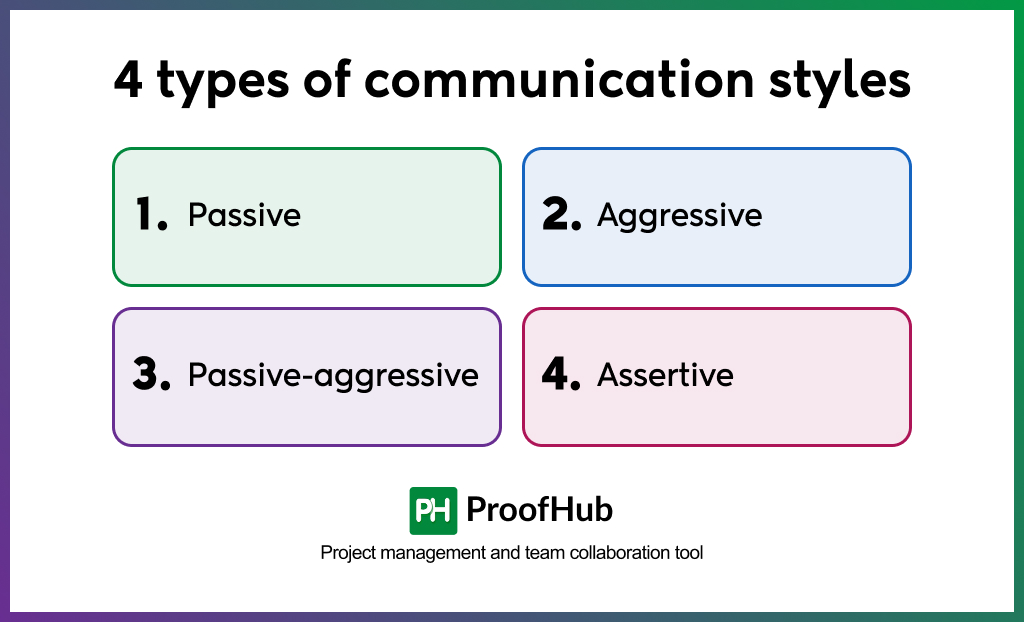Have you ever thought why two teams with the same deadlines, the same resources, and almost similar talent produce different results? One team seems aligned and confident, whilst the other seems confused.
The core problem that lies behind it is not strategy or workload; it is the communication style-the way managers talk, respond, and interact daily. In constantly evolving teams, the way a manager communicates doesn’t just affect how information flows; it also shapes team behavior, motivation, and trust.
A leader who communicates with clarity and respect builds confidence. One who confuses or controls unintentionally breeds stress, silence, or conflict.
And here’s the catch: most managers don’t even realize their style is creating a ripple effect.
But there’s good news: communication styles aren’t fixed; they can be recognized, adapted, and improved.
In this article, we’ll explore what communication styles are, their various types, how to identify your style as a leader, and how to manage diverse styles effectively using collaborative techniques.
Before learning about communication styles, take note of the importance of effective communication in a workplace setting.
What are communication styles?
In simple terms, communication style refers to how we express ourselves verbally, non-verbally, and emotionally when interacting with others.
It’s more than just the words we choose. It’s the tone of voice, pace, body language, facial expressions, clarity, and responsiveness that shape how a message is delivered and received.
In the workplace, a person’s communication style affects how:
- Ideas are shared
- Feedback is given and received
- Conflict is handled
- Collaboration unfolds
For leaders, it becomes even more critical because the way they communicate sets the tone for the whole team. It can either open doors for honesty and collaboration or shut them just as quickly.
Here’s where it gets interesting: people often default to a particular style, especially under pressure. Some avoid confrontation, and others dominate conversations. Some express themselves clearly, while others hide frustration behind politeness or silence.
According to experts, the four types of communication styles are:

- Passive
- Aggressive
- Passive-aggressive
- Assertive
Each style has a distinct pattern and a very real impact on how a team performs, connects, and grows. Recognizing these styles in yourself and others is the first step to building better team dynamics.
| Communication style | Key traits | Example phrase | Impact on teams | People on the Receiving end Feel |
|---|---|---|---|---|
| Passive | Avoids confrontation, defers decisions, unclear expectations | “I’m okay with whatever the team decides.” | Ambiguity, missed opportunities, and disengagement | Confused about expectations Uncertain about direction |
| Agressive | Dominates, interrupts, and focuses on winning | “You clearly don’t get how this works.” | Fear, low morale, stifled innovation | Intimidated or fearful Uncomfortable speaking up |
| Passive-agressive | Indirect, uses sarcasm, and withholds feedback | “Sure, I’ll do it like everything else around here.” | Resentment, confusion, eroded trust | Confused by mixed signals Unsure where they stand |
| Assertive | Clear, direct, respectful, solution-oriented | “I understand your concern. Let’s find a way forward.” | Trust, clarity, alignment, and high morale | Heard and respected Clear about expectations |
1. Passive communication
Passive communicators often prioritize harmony over clarity. They avoid conflict, hesitate to give feedback, and rarely assert their own needs or ideas. In simple words, they value others’ opinions over theirs. It is most likely for them to defer decisions or apologize for sharing input, fearing it might create friction.
For instance, you can hear passive communicators say phrases like-
“I’m okay with whatever the team decides.”
“It’s just a small thing, so I didn’t bring it up.”
As a manager, relying solely on passive communication can leave the team uncertain, causing employees to lose their direction and become disengaged. The critical issues may go unaddressed, and talented members may feel overlooked.
Also read: Team appreciation: Why should managers do it more often
2. Aggressive communication
Aggressive communicators are direct to the point of being confrontational or domineering. They may interrupt you, use a harsher tone, invade personal space, or maintain intense eye contact. Their language is often absolute or blaming.
Aggressive communicators might use these phrases-
“I’m right, and you’re wrong.”
“I’ll get my way no matter what.”
Aggressive communication creates fear and resentment, and emotional withdrawal. It discourages healthy debate, suppresses creativity, and ultimately damages morale, trust, and collaboration. The long-term effects of this not only drive your best people away but also fuel a toxic workplace culture.
3. Passive-aggressive communication
Passive-aggressive communicators, though they appear agreeable on the surface, are expressing frustrations implicitly. They might use sarcasm, mutter under their breath, or give the silent treatment. Their body language and words often don’t match.
These can be something they say:
“Sure, we can do things your way.” (muttering)
“That’s fine with me, but don’t be surprised if someone else gets mad.”
A passive-aggressive communication style can breed confusion and mistrust in a workplace. This style can help your team members struggle to understand your true intentions and causes unresolved issues, and imbalance team cohesion.
4. Assertive communication
Assertive communication is the foundation of strong leadership.
Assertive communicators express their needs and opinions clearly and respectfully, striking a balance between their own rights and those of others. They use open body language, a calm tone, and offer feedback in a constructive, non-threatening manner.
They could say phrases such as
“I understand your concern. Let’s work out a way that works for both of us.”
“Let’s clarify expectations so we’re all on the same page.”
This is the most effective communicative style for managers, which can help you build trust, clarity, and alignment by fostering a collaborative and high-performing team environment.
Also read: Read our article on effective communication strategies to connect better with your team at work.
The impact of each communication style on team behavior
The way leaders or managers communicate doesn’t just influence individual interactions; it tends to shape an entire team’s culture. Over time, these communication patterns determine whether a team becomes collaborative and motivated or highly disengaged and frustrated. Each communication style impacts how your team engages, makes decisions, and solves problems together.
Let’s have a look at the impact of different communication styles on team behavior!
1. Passive: Creates confusion and inaction
When a leader uses passive communication, they avoid giving direct feedback, hesitate to make decisions, and often go along with whatever others say. This creates confusion and a lack of clarity for the team.
Impact on team behavior
- Team members feel unsupported and unsure of what’s expected
- Motivation declines as priorities become unclear
- Accountability fades, leading to missed deadlines and delays
For example, a team member misses a deadline, but the manager says nothing. Later, the entire timeline slips, and no one knows why.
2. Aggressive: Triggers fear and silence
Aggressive leaders talk over others, use a harsh tone, and feel they are always “right” instead of being fair. This generally creates fear and tension in the team. Team members stop speaking up, creativity diminishes, and collaboration breaks down. With time, team morale drops, and the best performers quietly disengage or leave the organization.
Impact on team behavior
- Team members feel intimidated and stop contributing ideas
- Creativity suffers, and collaboration deteriorates
- Over time, morale drops, and high performers may disengage or leave
For example, during a meeting, the manager cuts off a team member mid-sentence and says, “We’re doing it my way, no more discussion.
3. Passive-aggressive: Breeds mistrust and tension
A leader who communicates in a passive-aggressive way doesn’t express their concerns openly. Instead, they may use sarcasm, send mixed messages, or express frustration without directly addressing the issues. This leads to confusion, mistrust, and hidden conflict.
Impact on team behavior
- Team members struggle to know where they stand,
- Unresolved issues quietly damage relationships and progress.
- Productivity suffers as clarity and cohesion erode
For example, a manager says, “Sure, I guess we can do it your way,” then rolls their eyes and later delays the task without explanation.
4. Assertive: Build trust and high performance
Leaders who communicate assertively are clear, respectful, and confident. They express expectations, give constructive feedback, and listen to others. This creates a safe, open environment where team members feel heard, valued, and aligned.
Impact on team behavior
- Fosters a culture of openness, trust, and mutual respect
- Encourages collaboration, accountability, and engagement
- Teams are more aligned, motivated, and empowered to perform at their best
For example, a team member misses a deadline. In the next stand-up, the manager says, “I noticed the deadline was missed. Can we talk about what happened and how we can prevent it next time?”
How do you identify your communication style as a manager?
You can identify your communication style as a manager by reflecting on your behavior, observing team responses, and seeking honest feedback. Many managers aren’t fully aware of how their communication comes across, especially during busy or stressful times. By paying attention to how you express yourself, how your team reacts, and how effectively messages are delivered and received, you can better understand your default style.
The following are some of the practical ways to assess and improve your communication habits for stronger leadership

1. Start with self-reflection
In the ordeal of identifying your communication style as a manager, you need to begin by asking yourself some questions to honestly review what your patterns are. Some examples of such questions are-
How do people typically respond to my messages?
Do team members seem engaged, confused, or hesitant to speak up?
Do I often need to clarify my instructions?
Are follow-up questions common, or do things move forward smoothly?
Am I frequently misunderstood?
Do I notice recurring misinterpretations or conflicts?
How comfortable am I with giving and receiving feedback?
Do I avoid tough conversations, or do I address issues directly and respectfully?
Do I adapt my communication based on the audience or situation?
Or do I tend to use the same approach regardless of context?
2. Ask for feedback from your team
There are times when your self-perception doesn’t suffice to fulfil the purpose. At that time, ask your team to give you feedback.
How to do it?
- Anonymous team surveys: Ask your team to evaluate your communication on various factors, such as clarity, tone, and responsiveness, through team surveys to encourage honest feedback.
- 1:1 conversations: Invite feedback in private settings. Ask, “Is there anything I could do to communicate more clearly or effectively?”
- Communication audits: Review past emails, meeting notes, or project chats. Look for recurring language, tone, or patterns such as hesitation, sarcasm, or assertiveness.
3. Observe non-verbal signals
Try to observe your body language, facial expressions, and tone of voice because they often say more than your words. You can also ask a trusted colleague to observe and share their impressions for added perspective.
If you do the following
- Do you maintain an open posture and steady eye contact (assertive)?
- Do you cross your arms, avoid eye contact, or fidget (passive)?
- Do you point, use intense gestures, or raise your voice (aggressive)?
- Do your words and body language ever contradict each other (passive-aggressive)?
4. Use a collaborative tool for better insights
Make use of collaborative tools to gather valuable data on your communication style. You can review messages, task comments, and project updates for tone and clarity. Check if your team members frequently request clarification and if instructions are clear or not. Also, evaluate the reactions of your team members to understand how your messages are received.
Also read: Get to know about the best internal communication tools and software to boost collaboration.
Conclusion
Assertive communication is a powerful communication style, but that doesn’t mean it’s always the right choice. Sometimes, you need to be gentle and hold back, even if it seems the right thing to do. Effective managers know how to adjust their leadership style according to the situation. What matters most is being aware and intentional with how you speak and listen.
But even with the right style, messages can still get lost, especially when teams are busy or working across different tools. That’s why structure is just as important as communication style. When communication is both thoughtful and well-organised, teams work more effectively, trust one another more, and stay aligned.
This is where ProofHub helps. It brings your team’s conversations, updates, tasks, and feedback into one clear space. So, regardless of how you communicate, whether calmly, directly, or carefully, your message remains straightforward to follow.
Frequently asked questions
Which communication style is best for the workplace?
Assertive communication is effective because it strikes a balance between clarity and respect. It fosters trust by encouraging open dialogue, reducing misunderstandings, and promoting effective collaboration, which leads to higher team morale and productivity.
What are the key differences between direct and indirect communication styles?
Direct communication is clear and focuses on straightforward messages, whilst indirect communication uses hints and context to preserve harmony. Directness ensures clarity; indirectness prioritizes relationships and avoids confrontation.
What impact do communication styles have on team dynamics and conflict resolution?
Communication styles influence trust, engagement, and conflict outcomes. Assertive styles promote openness and quick resolution, whereas passive or aggressive styles can lead to confusion, tension, and unresolved conflicts.
How do cultural differences shape communication preferences?
Cultural norms determine preferences for direct or indirect communication, feedback styles, and conflict handling. Understanding these differences helps managers avoid misunderstandings and build inclusive, effective teams.

